Marine
Life Society of South Australia Inc.
Newsletter
October
2005 No.
326
“understanding, enjoying & caring for our
oceans”
Next Meeting
This
will be the October General meeting and it will be held at the Conservation
Centre, 120 Wakefield Street, Adelaide on Wednesday 19th
October commencing at 7.30pm.
Our
speaker will be Robyn
Morcom who will be speaking on the new Dolphin
Sanctuary.
Contents
Fish Cleaning Talk by
Scoresby Shepherd and David Muirhead (Steve Reynolds)
More About Cleaner fish and Shrimps (Steve
Reynolds)
Weedy
Seadragon Protection (Philip Hall)
2006
Calendar
Shark Diving
in Manly Aquarium (Steve Reynolds)
REMINDER
Articles
for YOUR Newsletter are always required. The more people who write articles then
the wider the topic spread. Please do not leave it up to just a few. Articles of
any length are welcome.
This
Newsletter
The hardcopy of the Newsletter is in black and white as usual. If members prefer a colour PDF version then please email me.
Fish Cleaning Talk by Scoresby Shepherd and David
Muirhead
by Steve
Reynolds
Our Patron, Dr
Scoresby Shepherd gave a talk following our AGM in May. His talk was about his
recent work studying fish cleaners in SA waters. He has been observing five
species of fish and one species of shrimp that carry out fish cleaning services
at their chosen cleaning stations. Scoresby told us that there had been no
previous systematic study of the subject in southern Australia. He said that he
had recorded six species of fish cleaners in SA over some twenty years. This
included five fish species and one species of shrimp. The first fish species
that he discovered cleaning other fish was the Pencil Weed Whiting,
Siphonognathus beddomei in 1985. He said that
he had witnessed fish cleaning by this species some 16 times over 15 years since
then. Scoresby then listed the other four fish species that he has recorded
cleaning other fish. These were: the Moonlighter, Tilodon sexfasciatus, the Western Cleaner Clingfish,
Cochleoceps bicolor, the Blackspotted Wrasse,
Austrolabrus maculatus, and the Old Wife, Enoplosus armatus.
Of these species, the Blackspotted Wrasse had only
been seen cleaning at Rapid Bay jetty. The one species of fish cleaning shrimp
known in South Australia is Periclimenes
aesopius, (a species of Pontoniine (commensal) shrimp),
but so far no observations on its cleaning have ever been made. According to “A
Field Guide to Crustaceans of Australian Waters” by Diana Jones and Gary Morgan,
there are several species of Pontoniine shrimp and
three species of Periclimenes shrimp are
named. Scoresby went on to speak about ‘cleaning symbiosis’. He described the fish doing the fish cleaning as
‘the cleaner’ and the fish being cleaned as ‘the client’. He suggested that
cleaning involved a sensory stimulus to ‘the client’. He called this ‘tactile
stimulus’, tactile meaning ‘of touch’. Scoresby then discussed all of the things
that any cleaner would need to run a business. Things such as a site in a good
location, advertising, bold signs and clients. He suggested that ‘bold signs’
might include things like bright stripes and false eyespots (ocelli). He referred to these bold signs as ‘guild signals’.
Moonlighters, Western Cleaner Clingfish and Old Wife certainly have bold
stripes. Pencil Weed Whiting have ocelli, as do
juvenile Moonlighters. Western Cleaner Clingfish just have very prominent eyes.
Blackspotted Wrasses have numerous blackish spots on
the head and body. Females and juveniles also have a white bar and a white-edged
black spot on the caudal peduncle (just before the tail). Scoresby described
cleaning stations (site locations) as being ‘topographic’. Scoresby then went on
to describe the various different poses that client fish would adopt to indicate
to the cleaner the level of cleaning that they required. He had found that the
client’s pose determined the number of ‘cleaning bites’ received from cleaner
fish. He mentioned the risk of predation to fish being cleaned. We were told
about a forthcoming paper on the topic of fish cleaning. It was suggested that
cleaning stations need to be protected by the declaration of aquatic reserves or
marine protected areas, because fish cleaning is of positive benefit to the
health of a fish community. The last note that I recorded from Scoresby’s talk
was that he said that Moonlighters will actually clean each other. We presented
Scoresby with a 2006 calendar of SA marine life at the end of his presentation
to show our appreciation. The front cover of the calendar features two Western
Cleaner Clingfish. A school of Old Wives at Rapid Bay jetty also features in the
calendar (for the month of May). The picture was taken by Neville Skinner.
Scoresby has been collaborating with Society member David Muirhead for
photographic documentation of his work. David showed us lots of his underwater
slides which could be linked to Scoresby’s talk. There were pictures of the
cleaner fish listed by Scoresby, and others of fish apparently being cleaned. In
some cases it was quite obvious that fish were being cleaned, whilst other cases
were not so obvious but still a distinct possibility. One of the first slides
that he showed us was the one of the two Western Cleaner Clingfish which was
featured on the front cover of our 2006 calendar. The same slide is also the
main picture for the month of January 2006. He also showed us the same slide as
the small January insert featuring a Western Cleaner Clingfish at the Glenelg
Barge. David has discovered that quite a few of his slides of different fish
species feature cleaner fish and shrimps, which he had not previously noticed.
One of the slides that David showed us was slide number 1252 from our Photo
Index. It features a Pencil Weed Whiting, which seems to be cleaning a male
Rainbow Cale, Odax
acroptilus at Moana Reef in January 1999. Another
slide that he showed us featured a shrimp or two around a Southern Rock
Lobster, Jasus edwardsii at Wright Island, Victor Harbor. It was a
similar picture to the one featured for the month of June in our 2006 calendar.
There are two small shrimp in the top right hand corner of the Rock Lobster
picture. Another slide shown by David featured several Short-nose Weed Whiting
very close to a large flathead. It was a very entertaining topic presented by
both Scoresby and David. Many thanks to them both.
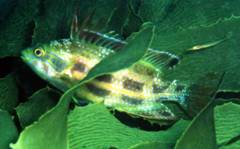
Pencil
Weed Whiting seemingly cleaning a male Rainbow Cale
More About Cleaner Fish and
Shrimps
by Steve
Reynolds
There is a
nice little section in Neville Coleman’s book “Australian Fish Behaviour” about
cleaner fish and shrimps. It discusses many of the topics covered by Scoresby
Shepherd and David Muirhead at our May meeting. It also raises the following
questions, which may be applied to SA fish cleaners: -
How many
species are full-time, part-time or opportunistic cleaners and which species are
they?
Does cleaning
occur during the day or the night and by which species?
What signals
are used by different cleaners and clients wishing to engage in a cleaning
situation?
What signals
are used by different cleaners and clients wishing to terminate a cleaning
situation?
How do the
different cleaners and clients learn to interpret these
signals?
What routines
do the cleaners and clients go through during a cleaning
situation?
What kind of
location and situation do cleaners and clients favour?
Which species
of clients do the different cleaners prefer?
Which species
of cleaner do the different clients prefer?
Do any fish
species mimic any of our SA cleaner fish species?
You may be
able to think of more questions of your own along these lines. In his book
“Coastal Fishes of South-eastern Australia”, Rudie Kuiter says that Western
Cleaner Clingfish have been “Regularly observed cleaning other fishes, probably
feeding on small parasites”. He also says that the fish that the Eastern Cleaner
Clingfish, Cochleoceps orientalis have been
observed cleaning most often include boxfishes,
porcupine fishes and morwongs. It is interesting to
note that both the Western and the Eastern Cleaner Clingfish were described in
1991 by (Barry?) Hutchins. This is quite recent compared to most fish species. I
still recall that early in my diving experience (late 70s) our then (MARIA)
President discussing an un- named clingfish that he would have loved to have
described back then. Rudie also said in his book that Pencil (or Long-nose) Weed
Whiting were “occasionally observed cleaning other fishes”. The activities of
Cleaner Wrasse, Labroides dimidiatus are described in detail in Rudie’s book as follows: -
“Specialised feeders, picking parasites off or attending to
wounds of other fishes. Individuals choose
strategic point on reef, often cave or elevated part of reef, to which other
fishes come for service. Such places are called cleaning stations. . . Large
predators (are) common customers. They assist by spreading their fins and
opening mouth to allow wrasses to clean teeth and gill rakers, often by swimming through mouth and gills.
Unfamiliar or new visitors (are) greeted with up-and-down dance-like motion
which appears to assure safety of Cleaner Wrasse”. The False Cleanerfish, Aspidontus
taeniatus is also discussed in the book. These
imposters feed “by biting unsuspecting prey, taking mainly bits of fin; more
experienced fishes learn to recognize the imposter and often chase it”. It is
interesting to note that the False Cleanerfish (1834)
was described some five years before the Cleaner Wrasse
(1839).
Here is an
interesting situation to finish off with. We hear that tropical anemonefish, or clown fish, form a relationship with sea
anemones. We hear how each fish becomes immune to the stinging tentacles of the
anemone by first receiving minor stings, adopting a particular swimming posture,
and producing a protective mucous coating. But what about shrimps which live on
sea anemones? How do they manage this? Neville Coleman’s book “Australian Fish
Behaviour” says that some shrimps, such as Holthuis’
commensal shrimp, Periclimenes holthuisi, live amongst sea anemones. Holthuis’ commensal shrimps in
anemones display as fish cleaners. It seems that they will lure clients well
within contact of the anemone’s tentacles yet the clients are not harmed at all.
Small fish have been observed hovering amongst the stinging tentacles while
being cleaned by the shrimp. Although the fish has to be quite careful around
the anemone, the anemone makes no attempt to sting the fish at
all.
Weedy Seadragon
Protection
by Philip Hall
On Tuesday
6th of September Margaret and I attended an afternoon tea at the
Walkerville Bowls Club to meet the Premier and some of his Ministers for an
informal community discussion.
I went with
two items for discussion, the Rapid Bay jetty situation and the lack of
protection for the Weedy Seadragon.
I was told
that the Jetty had been raised at a community meeting the previous evening and
they would not discuss it any further.
However we
were able to explain the plight of the Weedy Seadragon to several Ministers and
Government Staff. During one such discussion with Minister Rory McEwen the
Premier Mike Rann joined the group and we were able to quickly explain our
concerns to him. He left the group for a while and then came over to say he had
decided to be “the Premier to protect the Weedy
Seadragon”.
I was rather
skeptical but he then went to the microphone and after announcing the
presentation of computers to needy organisations said that because of
representations by the Marine Life Association (Society) of South Australia he
was going to immediately proclaim the Weedy Seadragon as being
protected.
There was loud
applause at this point led by you know who.
The Premier
later asked if I could let him have pictures of the Seadragons as he was not
quite certain as to what were the differences between the Leafy Seadragon and
the Weedy.
This I did by email
the same day. Here are copies of the pictures I sent.

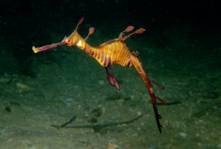
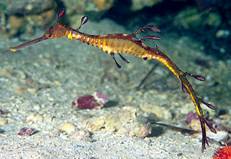
Copies of the 2006 MLSSA calendar
may still be
available.
If you would like a
copy then please contact us at this edress
marinelifesa@chariot.net.au
to order copies.
We have possibly sold
out but you can be put on a list should anyone return calendars as unsold.
Please be quick with
your order.
Philip
Hall
Shark Diving in Manly Aquarium
by Steve Reynolds
During my
recent trip to Sydney I was able to dive with Grey Nurse Sharks in the Manly
Aquarium. I pre-booked my dive through Shark Dive Extreme at Oceanworld Manly. I
was told that all that I needed to take for the dive were my bathers and a dry
towel. On the day of the dive, Noeleen and I caught a train into Circular Quay
at Sydney. After lunch we caught a ferry to Manly. Oceanworld was just a short
walk from the ferry wharf.
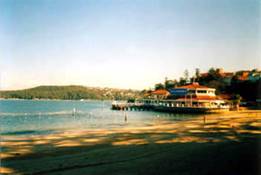
Photo of the
Manly Aquarium (taken by Noeleen Reynolds)
We checked in
early at the reception desk. We had plenty of time to explore the many aquarium
displays there. The Manly Aquarium is presented at a far different level to that
of the Sydney Aquarium but it is still very worthwhile. We had already visited
the Sydney Aquarium a few days earlier. We were now able to take a good look
around Oceanworld, catch up with a guided tour and also catch the end of one of
the day’s presentations about reptiles. The time soon came round for me to
attend a pre-dive talk and also to prepare for my dive. There were only two of
us taking part in the dive, a Mark Anthony and myself. Our instructor was Gavin.
He took us both to the shark dive office where we completed medical and waiver
forms before settling back to watch a “Jaws” movie. Well, not quite. It was a
promotional video to prepare us for our dive, but it started with the familiar
“Jaws” music to put us both in the mood. The dive equipment to be used was
explained to us. The procedure for the dive was described in detail, including
signals to be used. It was then time to gear up. It was about this time that we
met our second instructor who was called Chris. We were given vests and semi-dry
suits to wear. Next came boots, BCDs and weight belts. We weren’t going to be wearing any
fins in the aquarium so extra weights were placed into our BCDs. We entered a small pool where scuba tanks were then
strapped on to our backs. We were then given masks and gloves. After ducking our
heads beneath the surface of the pool, we followed our instructors. We had to
throw ourselves ‘superman’ style through a hatch into the shark aquarium.
Remember that we had no fins, so it was a little weird. We had to settle on to a
platform and, on our instructors’ signal, turn around and descend feet first to
the shallow bottom where they were waiting to ‘catch’ us. Our first exercise was
to do a practice walk around a pile of nearby rocks. We had to lean forward and
walk on tiptoes so that we didn’t fall backwards. It was about this time that a
large turtle swam over the top of us. We had to make sure that it didn’t swim
into us. Once Gavin and Chris were happy that we were comfortable and capable,
they got us both to follow them over the tube walkway to the middle of the
aquarium. This was the worst part for me. I had been told to jump up on to the
tube tunnel, but I struggled to do this without any fins. I finished up dragging
myself on to the tube where I had to turn around on the top. I then had to
descend feet first again with Gavin waiting to ‘catch’ me again. We waited for
Chris and Mark to join us before making our way along the other side of the tube
to our destination. I had to side step a small stingray on the bottom. We then
had to step up on to a narrow shelf where we could lean against the top of the
tunnel. We had to keep our hands close to our body. Gavin went over to the other
side of the tube so that he could photograph us both as many large Grey Nurse
Sharks swam close to us. Chris stayed just behind Mark and myself. We were continually ‘buzzed’ by two large stingrays,
a wobbegong shark and the Grey Nurses.
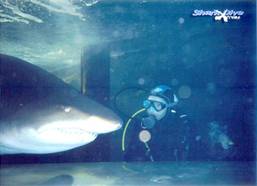
Photo of a large
Grey Nurse Shark passing by me (taken by Gavin)
We were able
to sex the Grey Nurse Sharks by checking for the presence of two claspers. The
presence of a pair of claspers meant that the shark was a male and no claspers
at all indicated that it was a female. Most of the Grey Nurses were over 3m
long. There was just one smaller shark which was less than two years old. It had
been bred and born in the aquarium. This ‘small’ shark was a good two metres
long. The large wobbegong, which was called “Brutus”, came and settled on the
tunnel right next to me on at least one occasion.
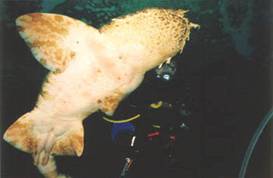
Photo of Brutus next
to me on the tunnel (taken by Noeleen Reynolds)
Gavin was kept
busy taking photos of Mark and I close to sharks and rays. The biggest stingray
was said to be 3m wide. Gavin picked a couple of discarded shark teeth up off of
the bottom of the aquarium and handed one each to Mark and myself. We both put
them into one of our gloves for safekeeping. Large fish such as Snapper and
Jewfish were also swimming around us all of the time. Large turtles were also
swimming around but our focus was usually on the Grey Nurses. The aquarium is
fairly large and about 4m deep. Viz, as you would
expect, is excellent. We spent something like 45 minutes in there, at least 30
minutes in the one spot. At the end of the photo session, we continued to walk
around the tube back towards our entry point. It was at about this time that
Gavin gave the 3m wide stingray a big hug. We then had to jump back onto the
tunnel and down to the other side again. At this point, Gavin had us pose for
photos with our partners standing next to us in the tunnel.
We then jumped back on
to the platform and, once more, threw ourselves ‘superman’ style through the
hatch back in to the small pool where we had started off. It had been a great
experience and Mark and I congratulated each other. We then thanked Gavin and
Chris for the experience of a lifetime. We were able to take our suits off under
a hot shower before changing back in to our dry clothes. It was then time to
re-join our partners and view the digital photos taken by Gavin. Photo prints
may be purchased, or a complete CD of the dive,
including a short video. We picked out our intended purchases and revisited the
aquarium whilst they were assembled for us. We were shown the results which were
then packaged up for us to take home with us. Oh, and I almost forgot that we
were given a certificate to show that we had both ‘dived and survived’ the shark
dive. It was then time to catch the ferry back to Circular Quay. A Shark Dive
Extreme experience includes admission to Oceanworld for the diver. Friends
receive 20% discount off of admission prices. You can enjoy the daily shows and
interactive presentations either before or after your shark dive. Visit
http://www.oceanworld.com.au/ or call 02 8251 7877
for shark and fish feeding and show times. For shark dive bookings and enquiries
phone 02 8251 7871, or email them at sharkdive@sydneyaquarium.com.au or visit
http://www.sharkdive.oceanworld.com.au/
.
Gavin and Chris were both highly professional, whilst maintaining a healthy
sense of humour. Work colleagues enquired whether or not I was scared of the big
toothy sharks. I explained that I wasn’t scared at all, just slightly nervous.
The whole experience is a reasonably safe calculated risk. Grey Nurse Sharks and
wobbegongs are not ‘man-eaters’. I thoroughly enjoyed myself and it was worth
every cent paid for the experience.